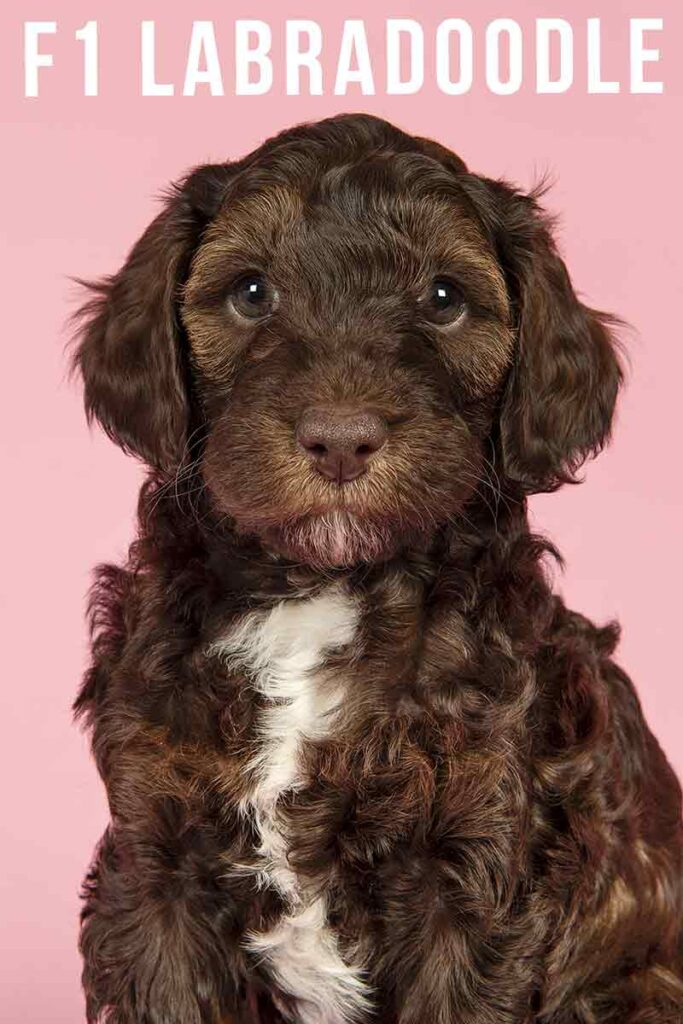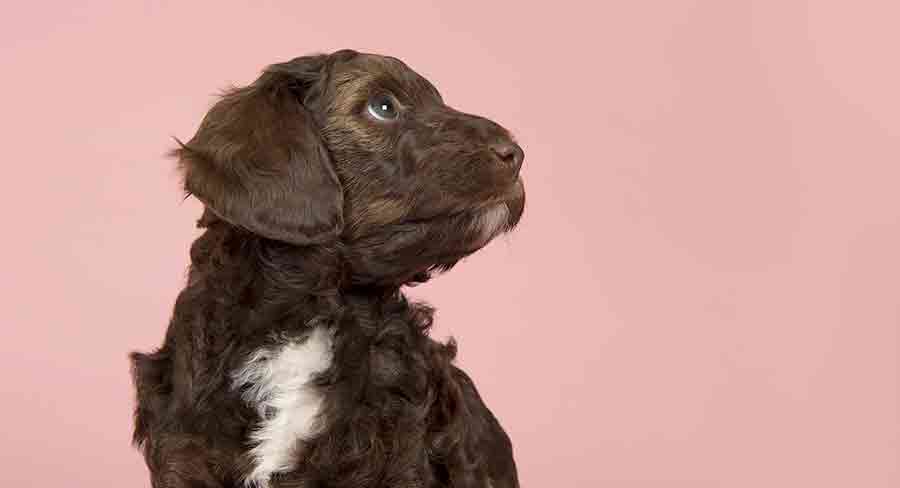If you’re searching for a Labradoodle, you may have noticed litters described as F1, and wondered what it means.
The letter and number F1 signify that a puppy is a first generation Labradoodle.
In other words, they’re the offspring of a purebred Labrador Retriever and a purebred Poodle.
What is an F1 Labradoodle?
Genetically an F1 Labradoodle is 50% Labrador Retriever and 50% Poodle.
The letter “F” in F1 stands for filial. This comes from the Latin word filialis, which translates to “son.”
In dog breeding, the “F” essentially tells you that the dog is no longer purebred.
And the number after it tells you many generations a dog is removed from their closest purebred ancestor.
An F1 Labradoodle is one generation removed from their nearest purebred ancestors – their parents.

Predicting F1 Labradoodle Qualities
Whenever two different dog breeds are crossed, the genetic inheritance of their puppies can vary significantly.
So some puppies will look and act more like a Lab, while others will be the spitting image of the Poodle, or they could be a mix of both parents.
For example, most people associate the Labradoodle with the low-shedding, curly Poodle coat. But some F1 Labradoodles have straight fur that resembles the Lab’s.
You never know exactly what the puppies will grow up to be like. There can even be big differences between puppies from the same litter!
The good news is that both the Lab and the Poodle have a lot to recommend them.
Let’s take a closer look at these two very different purebreds.
Labrador Retriever
Friendly, lovable, affectionate, outgoing, gentle, and intelligent – it’s no wonder the Labrador Retriever consistently ranks as America’s favorite dog.
These sociable canines bond with everyone, including other pets.
Despite their easygoing personality, Labs are high-energy dogs that need lots of exercise.
They were originally bred as waterdogs, helping hunters catch and retrieve waterfowl.
Labradors have a short, dense double-coat that comes in black, yellow, or chocolate.
Adults will stand from 21.5 to 24.5 inches and weigh from 55 to 80 pounds.
Standard Poodles
The Poodle’s flamboyant coat and reputation for being standoffish has incorrectly stereotyped the breed as being fussy and high-maintenance.
In reality Poodles are elegant, smart, versatile and athletic.
Although they’re closely associated with France, Poodles actually originated as duck retrievers in Germany over 400 years ago.
While some Poodles can be a bit aloof with strangers, owners will tell you that they are very loyal, affection pets.
In addition to Standard Poodles who typically stand about 24 inches and can weigh from 40 to 70 pounds, there are two other types of Poodle.
The Miniature Poodle is under 15 inches, and the Toy Poodle under 10 inches.
These dogs are all famous for their curly, low-shedding coat that comes in a wide array of colors and markings.
F1 Labradoodle Appearance
As we know, Labradoodles can inherit physical characteristics of either parent breed, or they can be a mix between the two.
Standard Labradoodles are usually medium to large dogs, standing from 21 to 24 inches and weighing in the 50 to 65 pound range. But some outliers may stay smaller, or grow even bigger. Especially if they had particularly small or large parents.
They commonly have that adorable “teddy bear” look with round expressive eyes and a soft curly coat that’s usually a solid color, such as golden, brown or eye-catching apricot.
There are 3 different coat texture possibilities. In addition to the sought after curly wool coat, their coat can be straight, or ‘fleecy’.
F1 Labradoodle Temperament
Labradoodles are prized for their good-natured, playful temperaments.
These friendly dogs love to be around people and also take to other pets.
Ideally, they find a home with an active family, because this high-spirited canine needs regular walks and playtime.
However, any dog, mixed breed or purebred is an individual with their own unique character.
Some of this is due to parentage, but puppies also need to be properly trained and socialized from an early age.
This will ensure they know how to behave in any situation.
Luckily, Labradoodles inherit brains from both sides of the family tree and both parents share an enthusiasm and aptitude for training.
Are F1 Labradoodles Healthier than their Parents?
There’s a persistent controversy around crossbreeding.
On the one hand, inbreeding and overuse of popular sires has increased inherited defects in purebred dogs. And there is some evidence that mixed breed dogs can be healthier and longer lived than purebreds, due to the phenomenon of ‘hybrid vigor’.
However, this is a statistical average, meaning some Labradoodles still inherit the genetic conditions of their parents.
The role of breeders
As one of the first designer dogs, Labradoodles have played a starring role in the surge of enthusiasm for mixed breeding.
Purebred enthusiasts argue that crossbreeding promotes unethical breeding practices.
And they’re partly right.
Because Labradoodles are popular, they are vulnerable to being exploited by puppy farmers and bad breeders. But the same is equally true of popular pedigree dogs.
Unscrupulous breeders care nothing for the welfare of animals, and breed without regard to health or welfare, creating dogs that have terrible temperaments and an overabundance of health problems.
So it’s vital to research breeders carefully, before committing to buying a puppy.
F1 Labradoodle Health
There are some health conditions that both Labs and Poodles are prone to, which means Labradoodles are as well.
Hip dysplasia occurs when the ball and socket of the hip joint do not grow at the same pace. This deformity causes the joint to deteriorate over time and can lead to painful arthritis.
Both breeds are also at risk for eye disorders, including progressive retinal atrophy (PRA), a serious condition that begins with not being able to see at night and leads to blindness.
Only purchase an F1 Labradoodle puppy from a breeder who has secured health tests for these conditions, for both parents.
One condition which can’t be screened for is bloat, or gastric torsion occurs when the stomach fills with gas and twists. This is a life-threatening condition that affects larger dog breeds, and especially deep chested breeds like the Poodle.
To protect your dogs against this, learn the symptoms, and how to protect against it through lifestyle choices.
What is an F2 Labradoodle?
Since F1 signifies a first generation Labradoodle, you’d be correct in thinking that an F2 is a second generation dog.
It means both parents were F1 Labradoodles.
Their closest purebred parent is two generations removed, i.e. a grandparent.
The exact genetic inheritance of F2 Labradoodles is even harder to predict.
F1 Labradoodles are 50% Lab and 50% Poodle, and when they become parents they pass on 50% of their DNA to their offspring.
Exactly which 50% they pass on to each pup is down to chance. So it’s possible to have puppies with mostly Labrador genes and puppies with mostly Poodle genes in the same F2 litter.
In fact it’s common for F2 litters to be more diverse in terms of looks and temperament than F1 litters.
So you may be wondering just how breeders can create more consistent litters.
What is an F1b Labradoodle?
The F1b Labradoodle is a cross between an F1 Labradoodle and a purebred Poodle or Labrador. Usually a Poodle, since the goal is typically to increase the odds of a non-shedding coat.
This means they’re about 75% Poodle and 25% Labrador Retriever.
The “b” in F1b stands for backcross, which means crossing a hybrid with a purebred that is the same as one of the parents.
Since they have consistently more Poodle DNA than F1 or F2 crosses, F1b Labradoodles are more consistent in looks and temperament. In a Poodle-ish way!
Is an F1 Labradoodle Right for Me?
Due to being first generation, F1 Labradoodles can be variable depending upon whether they take after the Lab or the Poodle.
Either of the parent breeds is intelligent, playful, and ideal for active families.
But if you’re counting on getting a puppy with a non-shedding coat and an outgoing personality, you need to be aware that this is not guaranteed.
Labradoodles’ genetic inheritance from their parents is decided at random, not by some mystic knowledge of what their future owners will find desirable!
What do you think of the F1 Labradoodle?
Let us know in the comments box down below!
References and Further Reading
Grégoire, L., “Genetic diversity, inbreeding and breeding practices in dogs: results from pedigree analyses,” Veterinary Journal, 2011
Wade, CM, “Inbreeding and genetic diversity in dogs: results from DNA analysis.” Veterinary Journal, 2011
Nicholas, FW et al., “Hybrid vigour in dogs?” The Veterinary Journal, 2016
Zhou, Z., et al., “Differential Genetic Regulation of Canine Hip Dysplasia and Osteoarthritis,” PLOS One, 2010
Petersen-Jones, SM, “A review of research to elucidate the causes of the generalized progressive retinal atrophies,” The Veterinary Journal, 1998
Upadhye, SV, et al., “Gastric torsion in a Labrador dog and its surgical correction,” Intas Polivet, 2010

